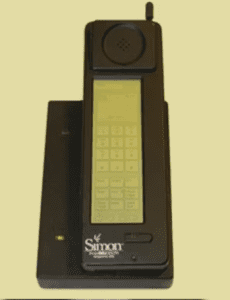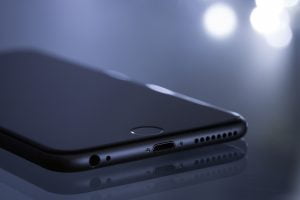Smartphones have become an essential part of our lives.
We use them to stay connected with friends and family, work on the go, and access entertainment.
But how did we get here?
In this article, we’ll explore the history of the first smartphone, from the first device to the powerful pocket-sized computers we have today.
So, get ready to embark on a journey through time, as we explore the fascinating history and evolution of smartphones!
The First Smartphone

The first smartphone was the IBM Simon, introduced in 1993.
Not called a smartphone then, but had many features associated with today’s smartphones.
Simon could make calls, send faxes and emails, and had a touchscreen display. It also had a calendar, an address book, and a stylus for taking notes.
A. Founding
The IBM Simon was developed by IBM engineer Frank Canova Jr. and was launched by BellSouth.
It was a groundbreaking device, but it was expensive and bulky. Costing around $900 at the time, which is equivalent to around $1,600 in today’s money.
Even though it was more expensive, IBM managed to sell more than 50,000 units of the Simon.
The IBM Simon was not a commercial success, but it paved the way for future smartphone development.
Over the years, smartphones have become more affordable and accessible, with millions of devices sold worldwide.
B. Description of the IBM Simon
The IBM Simon was a bulky device, measuring 8.5 inches long, 2.5 inches wide, and 1.5 inches thick.
It had a monochrome LCD touchscreen display that measured 4.5 inches diagonally.
The Simon had a stylus that let users draw on the screen and send the content as fax, which was a breakthrough feature.
It weighed 18 ounces and had a battery life of one hour of talk time and eight hours of standby time.
Can you believe that it took 14 to 16 hours to fully charge the IBM Simon’s battery, which only lasted for an hour?
The Revolution after the First Smartphone
After the IBM Simon, smartphones continued to evolve rapidly.
In 1996,
- Nokia introduced the Nokia 9000 Communicator, which was one of the first smartphones to feature a full keyboard and could be opened like a small laptop. And also could connect to the internet.
- It featured advanced capabilities for its time, including a built-in web browser, email client, and calendar.
In 2002,
- a company called Danger introduced a PDA called the Hiptop.
- It was also called the T-Mobile Sidekick and was popular with young people because it had a full keyboard and could send text messages easily.
- It also had a camera, which was a new feature at the time.
During 2003,
- BlackBerry introduced a smartphone called the BlackBerry 6210.
- It was the first device that combined a phone with email and internet capabilities.
- The BlackBerry was popular with business people because it had a secure messaging system and a keyboard that made it easy to send emails on the go.
In 2004,
- HP released the iPAQ h6315, which was one of the first smartphones to feature Wi-Fi and GPS capabilities.
- It was considered one of the most advanced smartphones of its time.
- It also had a 1.3-megapixel camera, which was a significant upgrade from the cameras on previous smartphones.
The Year 2007: The iPhone Revolutionizes Smartphones

In 2007, Apple introduced the iPhone, which revolutionized the smartphone industry with its touch screen display and app store.
- The iPhone was not the first touch screen phone, but it was the first to feature a large, multi-touch display that allowed users to interact with the device in new ways.
- In addition to its innovative touch screen, the iPhone was also the first smartphone to feature an app store, which allowed developers to create and distribute their own applications for the device.
- This opened up a new era of mobile computing, and the iPhone quickly became a sensation.
- It sold over 6 million units in its first year, and it set a new standard for smartphone design and functionality.
- The iPhone also inspired a new wave of competition in the smartphone market, with other companies rushing to develop their own touch screen devices with app stores of their own.
Smartphones Today
Modern smartphones are more powerful than ever before, and they offer a wide range of functions beyond just making phone calls and sending texts.
Some of the common technologies found in smartphones today include:
- High-resolution displays: Many smartphones now feature high-resolution displays that are capable of showing vibrant, lifelike colors and sharp images.
- Multiple cameras: Most smartphones now come with multiple cameras, including front-facing cameras for selfies and video calls, as well as rear-facing cameras with advanced features like optical zoom and image stabilization.
- Facial recognition and fingerprint sensors: Many smartphones now feature biometric security measures, such as facial recognition or fingerprint sensors, that allow users to unlock their devices quickly and easily.
- Artificial intelligence: Some of the latest smartphones are equipped with artificial intelligence capabilities, which can help improve performance and make the device easier to use.
- Augmented reality: Augmented reality (AR) technology is becoming increasingly common in smartphones, allowing users to experience digital content overlaid on the real world.
- 5G connectivity: The latest smartphones feature 5G connectivity, offering faster internet speeds and superior performance compared to earlier generations of wireless technology.
With these and many other features, modern smartphones are more versatile and powerful than ever before.
They have become indispensable tools for communication, entertainment, and productivity, and they continue to evolve and improve with each passing year.
Future Predictions

As technology continues to advance, smartphones are likely to continue evolving in new and exciting ways.
Future Advancements:
Some of the key areas where we can expect to see advancements in the coming years include:
- Foldable displays: Several smartphone manufacturers have already introduced devices with foldable displays, but this technology is still in its infancy.
- Improved battery life: One of the biggest challenges with modern smartphones is battery life. However, advances in battery technology could lead to devices with significantly longer battery life, making it easier to use them throughout the day without needing to recharge.
- Wearable devices: While smartwatches and fitness trackers have been around for a while, we can expect to see more smartphones that integrate with wearable devices in the future. These devices could offer even more functionality and convenience for users.
- Advanced biometric security: Facial recognition and fingerprint sensors are just the beginning when it comes to biometric security. In the future, we may see smartphones with more advanced biometric technologies, such as iris scanning or even voice recognition.
- Artificial intelligence: As artificial intelligence continues to advance, we can expect to see more smartphones with AI capabilities that can help users with tasks such as scheduling appointments, managing their calendars, and even making decisions based on their preferences and habits.
- 6G connectivity: While 5G is still relatively new, researchers and developers are already working on the next generation of wireless technology: 6G. This could offer even faster internet speeds and more reliable connections than 5G, paving the way for new applications and services that we can’t even imagine yet.
More advancements in the smartphone industry are expected in the coming years.
As always, the future is impossible to predict with certainty, but one thing is for sure: smartphones will continue to play an important role in our lives for years to come.
Conclusion
The smartphone has come a long way since the first device was introduced in 1992. The industry has been marked by rapid advancements in technology and intense competition among manufacturers, which has led to new features and capabilities being added to devices with each passing year.
Looking to the future, it’s clear that the smartphone will continue to be a major force in the world of technology. And with 6G connectivity on the horizon, the potential for what we can do with our smartphones is virtually limitless.
Smartphones have revolutionized the way we live and work, from staying connected with loved ones to being productive on the move. And with each new generation of devices, we can’t help but wonder what amazing innovations the future will bring.

My name is Harshil and I am a passionate writer, with a love for exploring new ideas and sharing them with the world.
I started this blog as a way to express my thoughts and share my ideas with a wider audience. My goal is to use my writing to connect with people, inspire new perspectives, and create a community of like-minded individuals who are passionate about learning and growth.
Whether I’m writing about Technology, personal development, or just sharing my thoughts on the world around us, I believe that words have the power to change the way we see things and make a positive impact on our lives.
So, come join me on this journey, and let’s see where our imaginations can take us!”


